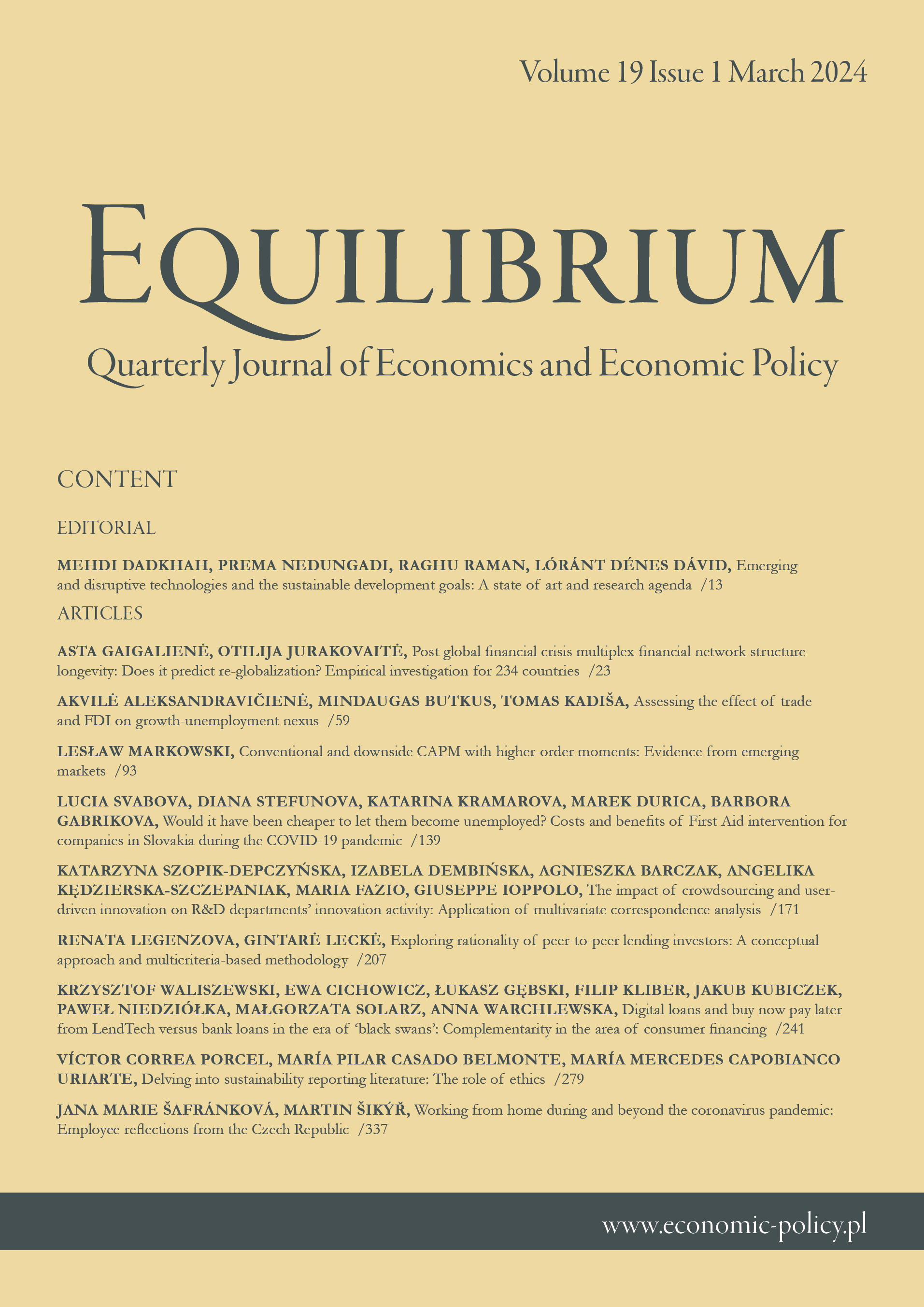基于预测的工具规则与决策:联系有多紧密?瑞典的案例
IF 6.2
Q1 ECONOMICS
Equilibrium-Quarterly Journal of Economics and Economic Policy
Pub Date : 2017-06-30
DOI:10.24136/EQ.V12I2.16
引用次数: 4
摘要
研究背景:瑞典中央银行于1999-2006年宣布实施斯文森的通胀预测目标制(IFT)概念。这意味着回购利率的决策过程取决于通胀预测。这个概念从严格的IFT和称为“经验法则”的决策算法演变为灵活的IFT。本文的目的是:(1)分析通货膨胀率和GDP增长率对回购利率决策的影响,(2)分析通货膨胀率和GDP增长率预测(两年内)对瑞典1999-2006年回购利率决策的影响。方法:对瑞典央行1999-2006年两年期的回购利率决策、CPI通胀率、GDP增长率、CPI通胀预测中心路径和GDP增长率预测中心路径(模式值)进行分析。研究基于泰勒型仪器规则和基于预测的泰勒型仪器规则。使用的方法是多元线性回归模型。瑞典央行在1999-2006年间实施了直接通胀预测目标制(DIFT)规则。决策算法基于CPI通胀预测和经验法则算法。确切的经验法则如下:如果两年内的通胀预测超出通胀目标1个百分点,那么央行将回购利率上调0.4个百分点;如果通胀预期低于目标,则央行将回购利率下调0.4个百分点。如果通胀预期与通胀目标相等,则回购利率保持不变。历史回购利率与理论估计的经验法则回购利率相差+/-0.28个百分点。本文章由计算机程序翻译,如有差异,请以英文原文为准。
The Forecasts-Based Instrument Rule and Decision Making : How Closely Interlinked? The Case of Sweden
Research background: The Central Bank of Sweden declared in years 1999–2006 the implementation of the Svensson’s concept of inflation forecast targeting (IFT). It means that the repo rate decision-making process depends on the inflation fore-casts. The concept evolved from the strict IFT with the decision-making algorithm called ‘the rule of thumb’ to the flexible IFT. Purpose of the article: The aim of the article is to: (1) analyze the influence of the inflation rate and GDP growth rate on the repo rate decisions, (2) analyze the influence of the inflation rate and GDP growth rate forecasts (in two year horizon) on the repo rate decisions in Sweden in years 1999–2006. Methods: The analysis encompasses the repo rates decisions, CPI inflation rate, GDP growth rate, central paths of CPI inflation forecasts and central paths of GDP growth rate forecasts (the mode values) in the two years horizon published by The Central Bank of Sweden in years 1999–2006. The studies are based on the Taylor-type instrument rule and forecast-based Taylor-type instrument rule. The methodology used is multiple linear regression models. Findings & Value added: The Central Bank of Sweden in years 1999–2006 implemented direct inflation forecast targeting (DIFT) rule. The decision-making algorithm was based on the CPI inflation forecasts and the rule of the thumb algorithm. The exact rule of the thumb was as follow: if the inflation forecast, in the two year forecast’s horizon exceeded the infla-tion target by 1 p.p., then the central bank raised the repo rate by 0.4 p.p; if it was below it, then the central bank reduced the repo rate by 0.4 p.p. If the inflation forecast was equal to the inflation target, then the repo rate remained unchanged. The historical repo rates differ from the theoretical estimated rule of the thumb’s repo rates by +/-0.28 p.p.
求助全文
通过发布文献求助,成功后即可免费获取论文全文。
去求助
来源期刊
CiteScore
9.20
自引率
3.50%
发文量
28
审稿时长
36 weeks
期刊介绍:
Equilibrium. Quarterly Journal of Economics and Economic Policy is a scientific journal dedicated to economics, which is the result of close cooperation between the Instytut Badań Gospodarczych/Institute of Economic Research (Poland) and Polish Economic Society and leading European universities. The journal constitutes a platform for exchange of views of the scientific community, as well as reflects the current status and trends of world science and economy.
The journal especially welcome empirical articles making use of quantitative methods in: Macroeconomics and Monetary Economics, International Economics, Financial Economics and Banking, Public Economics, Business Economics, Labor and Demographic Economics, Economic Development, and Technological Change, and Growth.
Current most preferable topics and special issues:
The economics of artificial intelligence: business potentials and risks;
Digitalization and entrepreneurship in economics;
Sustainable socio-economic development, environmental and ecological economics;
Transition in the energy market (improving energy efficiency, alternative energy sources, renewable energy, energy security).

 求助内容:
求助内容: 应助结果提醒方式:
应助结果提醒方式:


